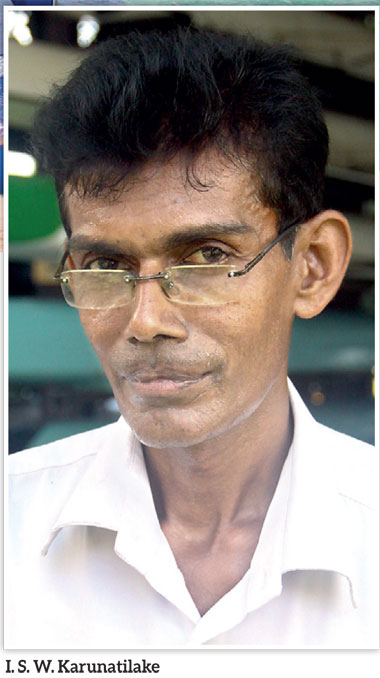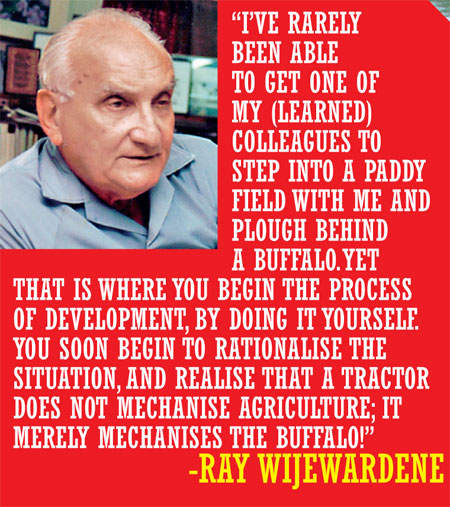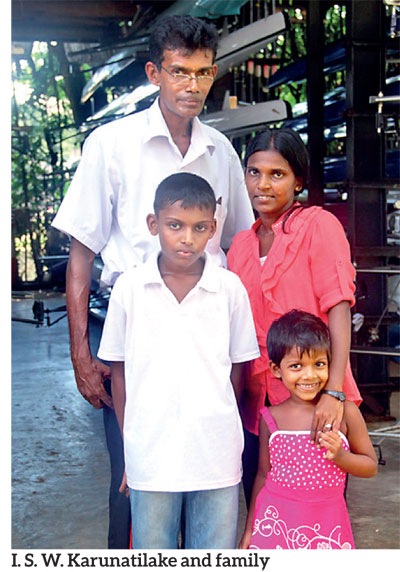 It is unsinkable and my tribute to Dr. Ray Wijewardene: Karunatilake
It is unsinkable and my tribute to Dr. Ray Wijewardene: Karunatilake
A young schoolboy is seen meddling with a jumble of wires, batteries and switches. His brows are knitted in concentration and he is completely focused on the task at hand. His goal is to build a mechanical doorbell for his home which does not have electricity. After hours of hard work, he straightens up to test his creation. A wide, joyful smile spreads across his youthful face when the doorbell emits a shrill buzzing sound.
That happened nearly four decades ago and the young boy from Horana working on the mechanical doorbell is in fact the protagonist in a story of great talent, sheer passion and copious amounts of hard work. He is none other than I. S. W. Karunatilake, the man who took home the coveted ‘Ray Award, 2012’ with his ‘Wave-less Boat’.
.jpg) There are several aspects that set my boat apart from commonplace boats in Sri Lanka. The boats which are widely used in Sri Lanka today are mono-hull boats. However, for my boat I used the concept of a catamaran, which
There are several aspects that set my boat apart from commonplace boats in Sri Lanka. The boats which are widely used in Sri Lanka today are mono-hull boats. However, for my boat I used the concept of a catamaran, which
is the more traditional boat in Sri Lanka. I developed my boat by using twin hulls. Because of this technology, the wave that usually strikes the water travels instead through the hollow mid-section of the hull
The Ray Award given by the Ray Wijewardene Charitable Trust (RWCT) is a lifetime award for innovation. The RWCT was established in January 2011 to promote the vision and ideas of the late Dr. Ray Wijewardene, the illustrious Sri Lankan scientist, engineer, inventor and specialist in both tropical farming and renewable energy. The Ray Award aims to honour the legacy of Dr. Wijewardene by recognising, encouraging and celebrating new inventions and the personalities behind these innovative creations.
The invention that earned Mr. Karunatilake the Ray Award in 2012 was a unique kind of boat made out of steel and aluminum that did not create waves in the water as it travelled, thus preventing river-bank erosion.
I met the inventor himself at the launch of his second wave-less boat held last Thursday at the Colombo Rowing Club where he also received a grant of one million rupees from the Commercial Bank, to assist him in commercialising his invention. Even though he was the man of the hour, Mr. Karunatilake seemed unfazed and humble.
Taking a quick break from the morning’s frenzy of events, Mr. Karunatilake told me about the long and winding road which brought him to where he is today.
.jpg)
.jpg) To get to where I am today I had to make several personal sacrifices. I worked on my invention for years, dedicating all my time to the cause
To get to where I am today I had to make several personal sacrifices. I worked on my invention for years, dedicating all my time to the cause
A wave of inspiration
“Ever since I was young I have been interested in creating new inventions. I started schooling at Devamulla Junior School and then went to Horana Vidyarathna

College. Even during my school days I would try my hand at making useful contraptions and gadgets. My childhood home did not have electricity. So I invented a generator that could supply power to the house. I also invented a mechanical doorbell which did not need electricity to work,” he said taking time off to narrate his story.
After his Advanced Level, Mr. Karunatilake decided to pursue Chartered Accounting and worked as a Senior Accountant and Auditor in several companies. But his itch to create new inventions was never cured. Even when he was employed in a very different line of work, innovative ideas for novel creations kept rolling around in his mind.
His most significant idea was set in motion when he came to own his late grandfather’s ferry service.
“My grandfather had a ferry service which was used to transport goods and people from Ratnapura to Chilaw across the ‘Kalu Ganga’. After he passed away, his ferry transport service was left to me. While I was involved in this transport service, it became a requirement to find a solution for the severe river bank erosion caused by boats and that was what got me thinking and inspired me to create my wave-less boat,” Mr. Karunatilake said with a smile and explained the concept and the technology behind his brainchild:
“There are several aspects that set my boat apart from commonplace boats in Sri Lanka. The boats which are widely used in Sri Lanka today are mono-hull boats. However, for my boat I used the concept of a catamaran, which is the more traditional boat in Sri Lanka. I developed my boat by using twin hulls. Because of this technology, the wave that usually strikes the water travels instead through the hollow mid-section of the hull.”
“In other words, the energy from motor boats travels outward, creating a huge wave which travels to the river banks and erodes them. But the energy created by my boat travels inwards. This energy is used to work the propeller and run the engine of the boat. So apart from preventing river bank erosion, my boat also recycles energy thus increasing the fuel efficiency. Since the energy from the wave is reused to take the boat forward, the fuel efficiency is 100 per cent more than in a regular motor boat.”
Mr. Karunatilake said the unique feature of the boat - the one I found most impressive – was that it was unsinkable. The technology used in the boat fills the airspace created by the boat so that the boat will not fill up with water and sink.
.jpg) When I won the award I promised myself that I would do Dr. Ray Wijewardene justice by further developing my invention. That is what inspired me to create the second wave-less boat which was launched today
When I won the award I promised myself that I would do Dr. Ray Wijewardene justice by further developing my invention. That is what inspired me to create the second wave-less boat which was launched today
He guaranteed the boat to be 100 per cent unsinkable and in addition topple-proof, thus eliminating the need to wear life-jackets while travelling in the boat.
To make his creation even more eco-friendly, Mr. Karunatilake had used recyclable material to build the boat.
“Usually, the boats are made of fiberglass which is not recyclable. However, I have used metal and steel so that my boat is recyclable and environmental-friendly,” he claimed.
Highlighting the importance of his creation he said Sri Lanka was in dire need of a quality boat service.
“We claim that we live in the Miracle of Asia. We rely heavily on the tourist industry. If we are to move forward, we need to develop and make use of our natural resources. Sri Lanka has more than 150 rivers and lakes but no proper boat service. Those usually used for tourism are basic fiberglass boats which cause great environmental damage. Furthermore, they are neither safe nor comfortable. But my boat is perfectly safe, comfortable and eco-friendly. My goal is to take my invention to

the market and help promote tourism in Sri Lanka and give the tourists a chance to see the true beauty of Sri Lanka in a very fulfilling way.”
A bumpy ride
Listening to Mr. Karunatilake impressed me about the extensive knowledge he seemed to have about science and technology and particularly the mechanisms behind boat-building. However, when asked how he became so knowledgeable about boats, he admitted that he did not know the answer.
“I have never received any formal education on engineering or about boats for that matter. I guess I was born with the talent. I have done extensive research on the subject on my own because that is my passion,” he said.
Mr. Karunatilake’s invention was not created in a day. His determination which gave life to his idea had taken him along a path full of rocks, hard knocks and sharp turns and up and down mountains.
“To get to where I am today I had to make several personal sacrifices. I worked on my invention for years, dedicating all my time to the cause. I even left my job as a senior audit manager. I used the funds I had saved up to build a house. I sold my personal vehicle. To this day, I live in a small house and travel in a motorbike or by bus,” he said. “However, I don’t regret any of it. This I believe is what I am born to do and this is what I will continue to do for as long as I can.”
It is indeed true that inventions are Mr. Karunatilake’s true calling or vocation in life. The proof of this lies in the many awards he has won for his inventions. Apart from winning the Ray Award, he has also won the Presidential award for the best design in 2007 and the International Silver prize at the Seoul International Invention Fair in 2009.
Tribute to Ray Wijewardene
“During the initial stages of building my first boat, I received much assistance from the National Science Foundation. The foundation helped me finance the project and it was with its assistance that I created the first wave-less boat which won the Ray Award in 2012,” Mr. Karunatilake said while profusely thanking the National Foundation.
Winning the Ray Award shed rays of light on Mr. Karunatilake’s path. It was a great honour and a source of encouragement for the budding inventor.
“Winning the Ray Award was a dream come true for me and it gave me great strength to move forward. It was as if Dr. Ray Wijewardene himself was blessing me,” he said with emotion. “When I won the award I promised myself that I would do Dr. Ray Wijewardene justice by further developing my invention. That is what inspired me to create the second wave-less boat which was launched today.”
The boat that won the award was much bigger with seating capacity for about 60 people. However, the second wave-less boat is designed to accommodate four people and is ideal for the tourism industry. He used his own personal funds to finance the development of the boat.
“Today I dedicate this invention to Dr. Ray Wijewardene and the great science and innovation legacy he has left behind.”
A master of other inventions
While building boats seem to be his first love, Mr. Karunatilake is also the mastermind behind many other inventions. One of his creations is a unique stove which can be lighted with easily-accessible organic material such as twigs and leaves.
“It is still in the testing stages but I can say for sure that it is a success. We have been using it in our own household for more than six months and it works very well. I designed it especially for use in rural households so that they won’t need to purchase gas to do their cooking.”

Another invention is a low-cost soil block machine which can make bricks by compressing soil.
“This is the technology used in developed countries to build large buildings and hotels. If Sri Lanka is expecting such large foreign investments to come into the country, then we need to stay ahead of the game. Such a machine costs about six million rupees in the market. However, my invention costs only about Rs.300,000 so it will be extremely useful.”
The woes of inventors
However, Mr. Karunatilake has faced several concerns when taking his new inventions forward.
He said he was disappointed and down-hearted when coming across so many obstacles to find financial backing for his inventions. Therefore, some of his inventions are still in the pipeline and waiting to come out their shells.
“Sri Lanka has many talented people and bright minds. However, they don’t have anyone to support their inventions and market them properly. Banks and other financial institutions are reluctant to provide financial assistance to inventors because the institutions don’t have faith in the creations. This is very discouraging. It is a setback for inventors like myself. We cannot afford to finance and market these projects all by ourselves.” Mr. Karunatilake said.
Support from family
However, no matter what difficulties Mr. Karunatilake faced, he said he had one source of unwavering support and that was his family.
He said his wife, son and two daughters were always by his side, every step of the way.
.jpg) He is unbelievably committed and he never gives up. I am so happy that he is following his dreams and it makes me even happier to see them coming true. We have three children. Our eldest daughter Maleesha is 13 years old, our only son is 11 years old and our youngest daughter is four years old.They are all so proud of their father and want to follow in his footsteps,” she said animatedly
He is unbelievably committed and he never gives up. I am so happy that he is following his dreams and it makes me even happier to see them coming true. We have three children. Our eldest daughter Maleesha is 13 years old, our only son is 11 years old and our youngest daughter is four years old.They are all so proud of their father and want to follow in his footsteps,” she said animatedly
“They are my silent cheerleaders always encouraging me; never letting me down and without whom I couldn’t be where I am today,” Mr. Karunatilake said.
Smiling shyly and with eyes glinting proudly, his wife Jayamini said she was elated by her husband’s achievements.
“He is unbelievably committed and he never gives up. I am so happy that he is following his dreams and it makes me even happier to see them coming true. We have three children. Our eldest daughter Maleesha is 13 years old, our only son is 11 years old and our youngest daughter is four years old. They are all so proud of their father and want to follow in his footsteps,” she said animatedly.
Bidding goodbye to the courageous Mr. Karunatilake and his family, I turned to look back at the wave-less boat floating proudly in the Beira lake as a testament of the famous adage that, ‘you can do anything you set your mind to.’
 It is unsinkable and my tribute to Dr. Ray Wijewardene: Karunatilake
It is unsinkable and my tribute to Dr. Ray Wijewardene: Karunatilake.jpg) There are several aspects that set my boat apart from commonplace boats in Sri Lanka. The boats which are widely used in Sri Lanka today are mono-hull boats. However, for my boat I used the concept of a catamaran, which
There are several aspects that set my boat apart from commonplace boats in Sri Lanka. The boats which are widely used in Sri Lanka today are mono-hull boats. However, for my boat I used the concept of a catamaran, which.jpg)
.jpg) To get to where I am today I had to make several personal sacrifices. I worked on my invention for years, dedicating all my time to the cause
To get to where I am today I had to make several personal sacrifices. I worked on my invention for years, dedicating all my time to the cause College. Even during my school days I would try my hand at making useful contraptions and gadgets. My childhood home did not have electricity. So I invented a generator that could supply power to the house. I also invented a mechanical doorbell which did not need electricity to work,” he said taking time off to narrate his story.
College. Even during my school days I would try my hand at making useful contraptions and gadgets. My childhood home did not have electricity. So I invented a generator that could supply power to the house. I also invented a mechanical doorbell which did not need electricity to work,” he said taking time off to narrate his story..jpg) When I won the award I promised myself that I would do Dr. Ray Wijewardene justice by further developing my invention. That is what inspired me to create the second wave-less boat which was launched today
When I won the award I promised myself that I would do Dr. Ray Wijewardene justice by further developing my invention. That is what inspired me to create the second wave-less boat which was launched today the market and help promote tourism in Sri Lanka and give the tourists a chance to see the true beauty of Sri Lanka in a very fulfilling way.”
the market and help promote tourism in Sri Lanka and give the tourists a chance to see the true beauty of Sri Lanka in a very fulfilling way.”
.jpg) He is unbelievably committed and he never gives up. I am so happy that he is following his dreams and it makes me even happier to see them coming true. We have three children. Our eldest daughter Maleesha is 13 years old, our only son is 11 years old and our youngest daughter is four years old.They are all so proud of their father and want to follow in his footsteps,” she said animatedly
He is unbelievably committed and he never gives up. I am so happy that he is following his dreams and it makes me even happier to see them coming true. We have three children. Our eldest daughter Maleesha is 13 years old, our only son is 11 years old and our youngest daughter is four years old.They are all so proud of their father and want to follow in his footsteps,” she said animatedly